Performance of a Heat-Pipe Cooled Concentrated Photovoltaic/Thermoelectric Hybrid System
Abstract
:1. Introduction
1.1. GaInP/GaAs/Ge Multijunction CPV Cells
1.2. Heat Pipes
1.3. Thermoelectric Generators
2. The Experimental Setup
- i.
- Employing a heat pipe for a passive (no additional cost for cooling pumps or motors, etc.), fast, and efficient removal of heat accumulated on the CPV, which increases its efficiency.
- ii.
- Utilizing such heat to generate electrical power by means of thermoelectric generators. This power is added to the total system power.
- i.
- LHP+HS: in which the CPV is connected to a long HP (25 cm) and the fins heat sinks are thermally attached directly on either sides of the second copper block. No TEGs are involved in this configuration and the CPV is the only source of electric power.
- ii.
- SHP+HS: in which the CPV is connected to a short HP (15 cm) and the fins heat sinks are thermally attached directly on either sides of the second copper block. No TEGs are involved in this configuration and the CPV is the only source of electric power.
- iii.
- LHP+TEG+HS: in which CPV is connected to a long HP. The second copper block is coupled with two TEGs attached to fins heat sinks. Total generated power is the CPV power in addition to the TEG power.
- iv.
- SHP+TEG+HS: in which CPV is connected to a short HP. The second copper block is coupled with two TEGs attached to fins heat sinks. Total generated power is the CPV power in addition to the TEG power.
3. Results and Discussion
4. Conclusions
Author Contributions
Funding
Institutional Review Board Statement
Informed Consent Statement
Conflicts of Interest
References
- Routhier, A.F.; Honsberg, C. Using PV and Thermal Energy Storage to Decrease Carbon Dioxide Emissions. In Proceedings of the 2018 IEEE 7th World Conference on Photovoltaic Energy Conversion (WCPEC) (A Joint Conference of 45th IEEE PVSC, 28th PVSEC & 34th EU PVSEC), Waikoloa, HI, USA, 10–15 June 2018; pp. 1477–1480. [Google Scholar]
- Solar PV—Analysis. Available online: https://www.iea.org/reports/solar-pv (accessed on 10 December 2022).
- Renewable Power Generation Costs in 2020. Available online: https://www.irena.org/Publications/2021/Jun/Renewable-Power-Costs-in-2020 (accessed on 21 January 2023).
- Photovoltaic Cost Reduction—An Overview|ScienceDirect Topics. Available online: https://www.sciencedirect.com/topics/engineering/photovoltaic-cost-reduction (accessed on 10 December 2022).
- Mariotti, S.; Turkestani, M.A.; Hutter, O.S.; Papageorgiou, G.; Major, J.D.; Swallow, J.; Nayak, P.K.; Snaith, H.J.; Dhanak, V.R.; Durose, K. Direct Silicon Heterostructures With Methylammonium Lead Iodide Perovskite for Photovoltaic Applications. IEEE J. Photovolt. 2020, 10, 945–951. [Google Scholar] [CrossRef]
- Zsiborács, H.; Hegedűsné Baranyai, N.; Vincze, A.; Háber, I.; Weihs, P.; Oswald, S.; Gützer, C.; Pintér, G. Changes of Photovoltaic Performance as a Function of Positioning Relative to the Focus Points of a Concentrator PV Module: Case Study. Appl. Sci. 2019, 9, 3392. [Google Scholar] [CrossRef]
- Du, B.; Hu, E.; Kolhe, M. Performance Analysis of Water Cooled Concentrated Photovoltaic (CPV) System. Renew. Sustain. Energy Rev. 2012, 16, 6732–6736. [Google Scholar] [CrossRef]
- Theristis, M.; O’Donovan, T.S. Electrical-Thermal Analysis of III–V Triple-Junction Solar Cells under Variable Spectra and Ambient Temperatures. Sol. Energy 2015, 118, 533–546. [Google Scholar] [CrossRef]
- Belhadj, W.; Timoumi, A.; Dakhlaoui, H.; Alhashmi Alamer, F. Design and Optimization of One-Dimensional TiO2/GO Photonic Crystal Structures for Enhanced Thermophotovoltaics. Coatings 2022, 12, 129. [Google Scholar] [CrossRef]
- Moiz, S.A.; Alahmadi, A.N.M.; Karimov, K.S. Improved Organic Solar Cell by Incorporating Silver Nanoparticles Embedded Polyaniline as Buffer Layer. Solid-State Electron. 2020, 163, 107658. [Google Scholar] [CrossRef]
- Moiz, S.A.; Alahmadi, A.N.M.; Aljohani, A.J. Design of Silicon Nanowire Array for PEDOT:PSS-Silicon Nanowire-Based Hybrid Solar Cell. Energies 2020, 13, 3797. [Google Scholar] [CrossRef]
- Ahmadinejad, M.; Moosavi, R. Energy and Exergy Evaluation of a Baffled-Nanofluid-Based Photovoltaic Thermal System (PVT). Int. J. Heat Mass Transf. 2023, 203, 123775. [Google Scholar] [CrossRef]
- Ahmadinejad, M.; Soleimani, A.; Gerami, A. The Effects of a Novel Baffle-Based Collector on the Performance of a Photovoltaic/Thermal System Using SWCNT/Water Nanofluid. Therm. Sci. Eng. Prog. 2022, 34, 101443. [Google Scholar] [CrossRef]
- Ahmadinejad, M.; Soleimani, A.; Gerami, A. Performance Enhancement of a Photovoltaic Thermal (PVT) System with Sinusoidal Fins: A Quasi-Transient Energy-Exergy Analysis. Int. J. Green Energy 2022, 0, 1–19. [Google Scholar] [CrossRef]
- Refaey, H.A.; Abdelrahman, M.A.; Alharthi, M.A.; Bendoukha, S.; Khan, S.G.; Emam, M. Passive Cooling of Highly-Concentrator Triple-Junction Solar Cell Using a Straight-Finned Heat Sink: An Experimental Investigation. Case Stud. Therm. Eng. 2022, 40, 102521. [Google Scholar] [CrossRef]
- Lashin, A.; Al Turkestani, M.; Sabry, M. Concentrated Photovoltaic/Thermal Hybrid System Coupled with a Thermoelectric Generator. Energies 2019, 12, 2623. [Google Scholar] [CrossRef]
- Sabry, M.; Lashin, A.; Al Turkestani, M. Experimental and Simulation Investigations of CPV/TEG Hybrid System. J. King Saud Univ. Sci. 2021, 33, 101321. [Google Scholar] [CrossRef]
- King, R.; Boca, A.; WP, H.; Liu, X.-Q.; Bhusari, D.; Larrabee, D.; Edmondson, K.; Law, D.; Fetzer, C.; Mesropian, S.; et al. Band-Gap-Engineered Architectures for High-Efficiency Multijunction Concentrator Solar Cells. In Proceedings of the 24th European Photovoltaic Solar Energy Conference and Exhibitio, Hamburg, Germany, 21–24 September 2009. [Google Scholar] [CrossRef]
- Cotal, H.; Fetzer, C.; Boisvert, J.; Kinsey, G.; King, R.; Hebert, P.; Yoon, H.; Karam, N.H. III-V Multijunction Solar Cells for Concentrating Photovoltaics. Energy Environ. Sci. 2009, 2, 174–192. [Google Scholar] [CrossRef]
- Paulescu, M. Weather Modeling and Forecasting of PV Systems Operation. In Green Energy and Technology, 1st ed.; Springer: London, UK, 2013; ISBN 978-1-4471-4649-0. [Google Scholar]
- Theristis, M.; Venizelou, V.; Makrides, G.; Georghiou, G.E. Chapter II-1-B - Energy Yield in Photovoltaic Systems. In McEvoy’s Handbook of Photovoltaics, 3rd ed.; Kalogirou, S.A., Ed.; Academic Press: New York, NY, USA, 2018; pp. 671–713. ISBN 978-0-12-809921-6. [Google Scholar]
- Nishioka, K.; Takamoto, T.; Agui, T.; Kaneiwa, M.; Uraoka, Y.; Fuyuki, T. Annual Output Estimation of Concentrator Photovoltaic Systems Using High-Efficiency InGaP/InGaAs/Ge Triple-Junction Solar Cells Based on Experimental Solar Cell’s Characteristics and Field-Test Meteorological Data. Sol. Energy Mater. Sol. Cells 2006, 90, 57–67. [Google Scholar] [CrossRef]
- Qu, H.; Li, X. Temperature Dependency of the Fill Factor in PV Modules between 6 and 40 °C. J. Mech. Sci. Technol. 2019, 33, 1981–1986. [Google Scholar] [CrossRef]
- Singh, P.; Ravindra, N.M. Temperature Dependence of Solar Cell Performance—An Analysis. Sol. Energy Mater. Sol. Cells 2012, 101, 36–45. [Google Scholar] [CrossRef]
- Spectrolab. Available online: https://www.spectrolab.com/photovoltaics.html (accessed on 23 April 2022).
- Kinsey, G.S.; Pien, P.; Hebert, P.; Sherif, R.A. Operating Characteristics of Multijunction Solar Cells. Sol. Energy Mater. Sol. Cells 2009, 93, 950–951. [Google Scholar] [CrossRef]
- Faghri, A.; Zhang, Y. 11—Two-phase flow and heat transfer. In Transport Phenomena in Multiphase Systems; Faghri, A., Zhang, Y., Eds.; Academic Press: Boston, MA, USA, 2006; pp. 853–949. ISBN 978-0-12-370610-2. [Google Scholar]
- Reay, D.; McGlen, R.; Kew, P. Heat Pipes: Theory, Design and Applications; Butterworth-Heinemann: Oxford, UK, 2013; ISBN 978-0-08-098279-3. [Google Scholar]
- Sangdot, R.; Patel, H. A Review on Photovoltaic Panel Cooling Using Heat Pipe. IJSDR 2016, 1, 573–576. [Google Scholar]
- Anderson, W.; Dussinger, P.; Sarraf, D.; Tamanna, S. Heat Pipe Cooling of Concentrating Photovoltaic Cells. In Proceedings of the 2008 33rd IEEE Photovoltaic Specialists Conference, San Diego, CA, USA, 11–16 May 2008. [Google Scholar] [CrossRef]
- Zohuri, B. Chapter 6—Heat Pipe Driven Heat Exchangers to Avoid Salt Freezing and Control Tritium. In Molten Salt Reactors and Integrated Molten Salt Reactors; Zohuri, B., Ed.; Academic Press: New York, NY, USA, 2021; pp. 197–228. ISBN 978-0-323-90638-8. [Google Scholar]
- Shirazy, M.R.S.; Fre´chette, L.G. A Parametric Investigation of Operating Limits in Heat Pipes Using Novel Metal Foams as Wicks; American Society of Mechanical Engineers Digital Collection; American Society of Mechanical Engineers: New York, NY, USA, 1 March 2011; pp. 575–583. [Google Scholar]
- Yang, M.-Z.; Wu, C.-C.; Dai, C.-L.; Tsai, W.-J. Energy Harvesting Thermoelectric Generators Manufactured Using the Complementary Metal Oxide Semiconductor Process. Sensors 2013, 13, 2359–2367. [Google Scholar] [CrossRef] [PubMed]
- Chapter 11: Energy Harvesters for Powering Wireless Systems—Handbook of Mems for Wireless and Mobile Applications [Book]. Available online: https://www.oreilly.com/library/view/handbook-of-mems/9780857092717/xhtml/B9780857092717500116.htm (accessed on 11 December 2022).
- Yousefi, E.; Nejad, A.A.; Rezania, A. Higher Power Output in Thermoelectric Generator Integrated with Phase Change Material and Metal Foams under Transient Boundary Condition. Energy 2022, 256, 124644. [Google Scholar] [CrossRef]
- Tuoi, T.T.K.; Toan, N.V.; Ono, T. Theoretical and Experimental Investigation of a Thermoelectric Generator (TEG) Integrated with a Phase Change Material (PCM) for Harvesting Energy from Ambient Temperature Changes. Energy Rep. 2020, 6, 2022–2029. [Google Scholar] [CrossRef]
- Jaziri, N.; Boughamoura, A.; Müller, J.; Mezghani, B.; Tounsi, F.; Ismail, M. A Comprehensive Review of Thermoelectric Generators: Technologies and Common Applications. Energy Rep. 2020, 6, 264–287. [Google Scholar] [CrossRef]

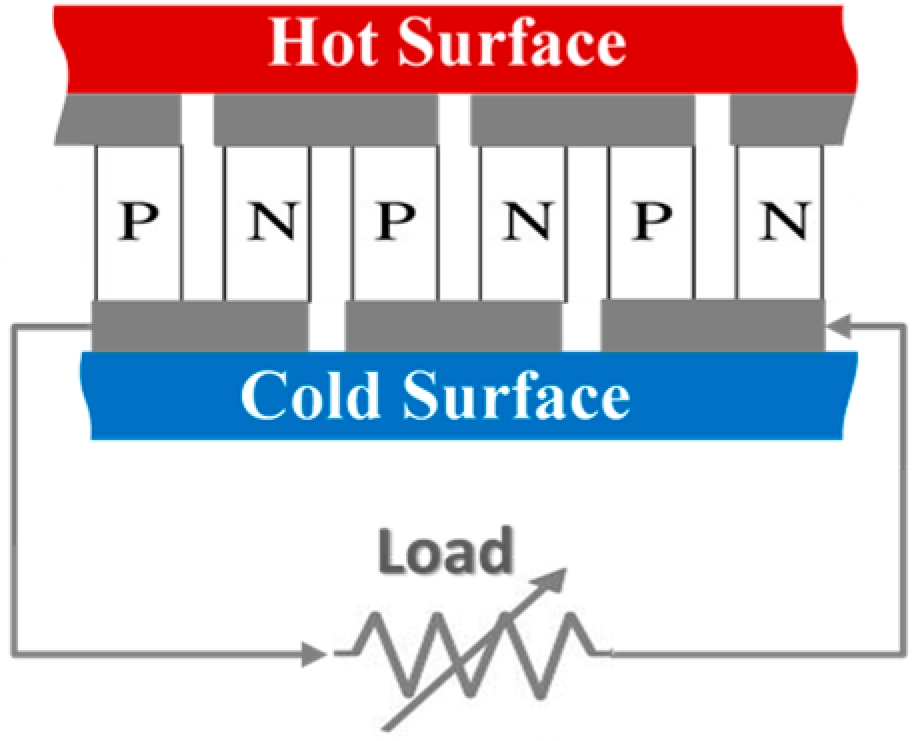
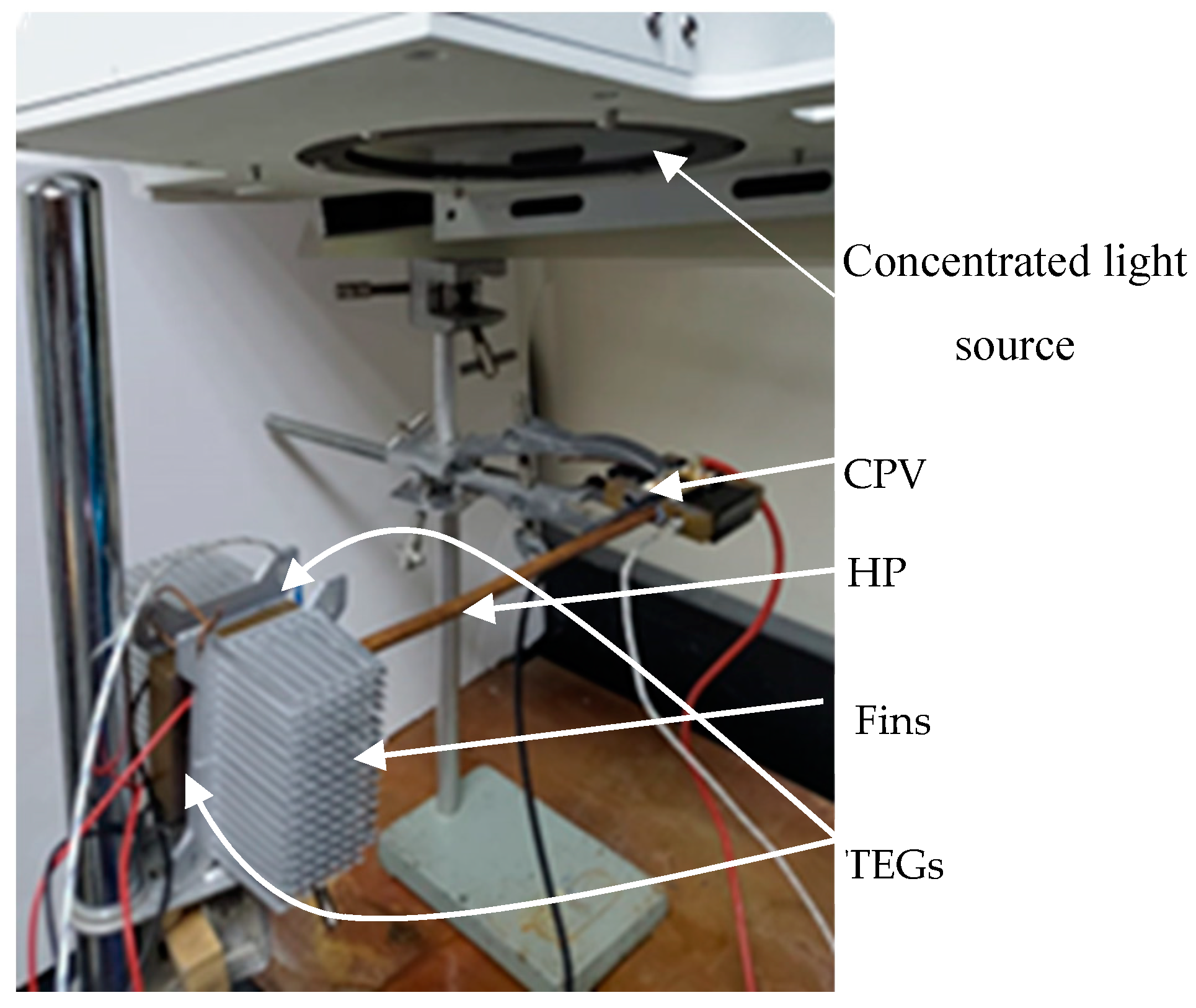

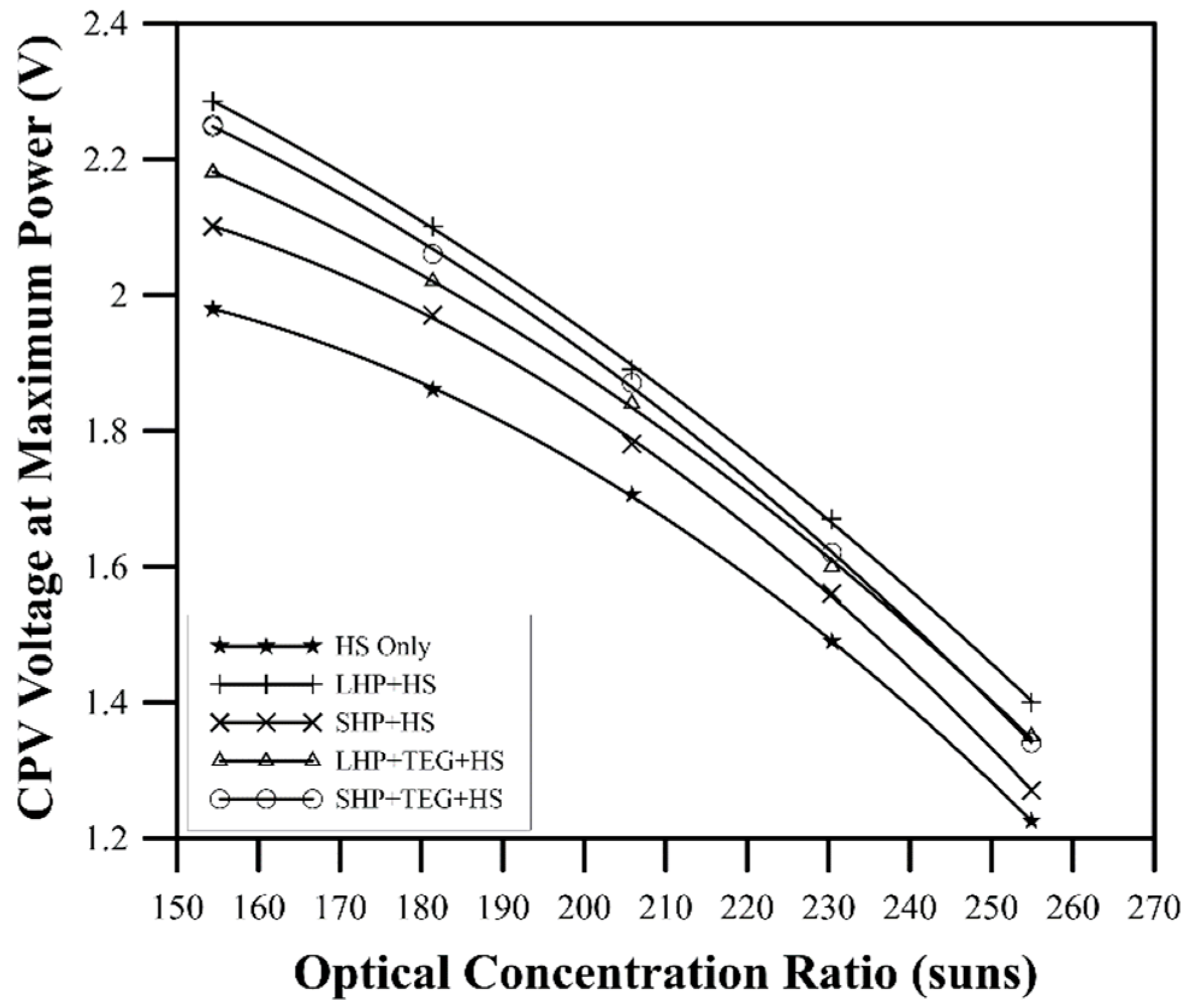
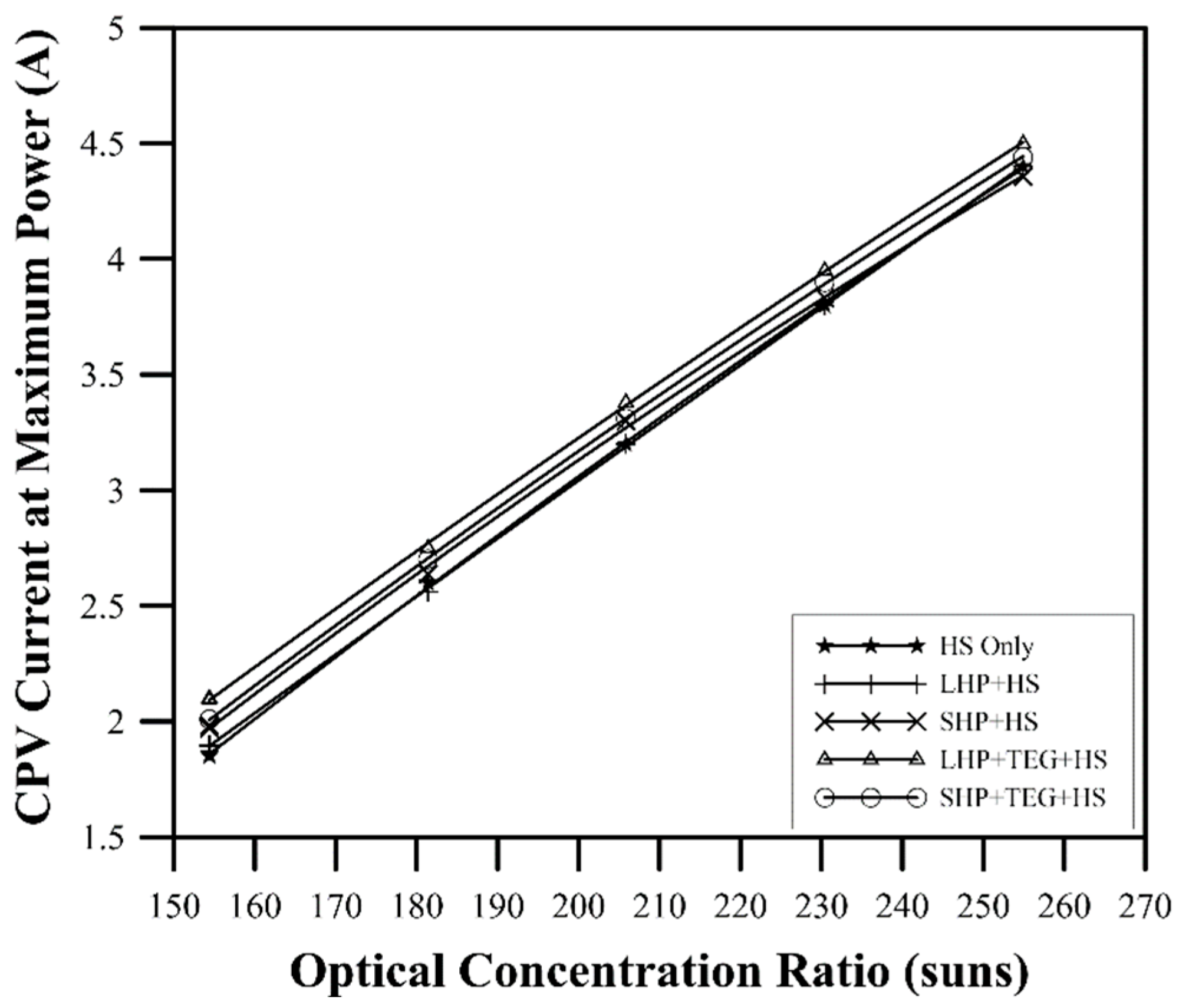
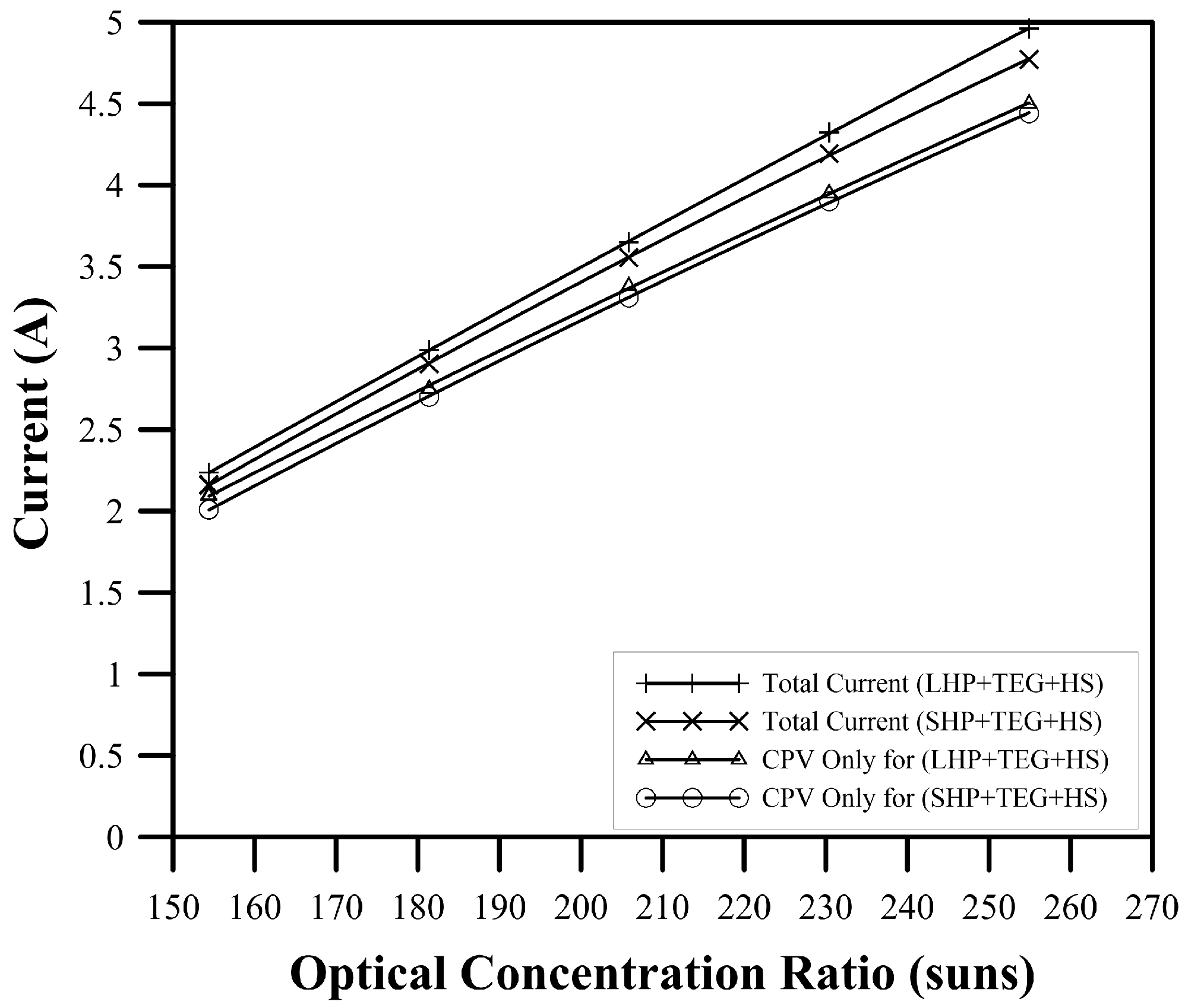



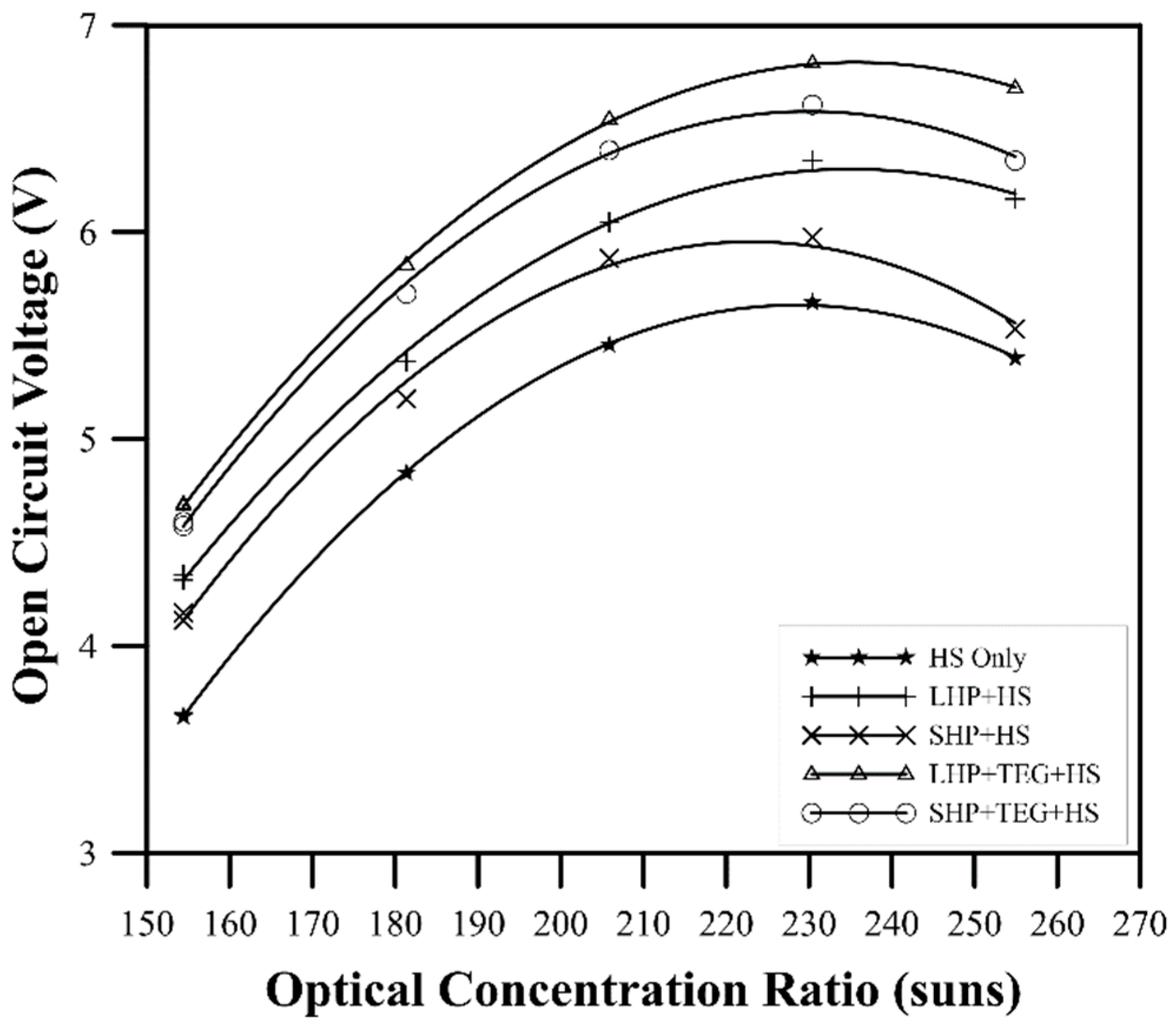
| Solar Simulator | Illuminated area | 0.1 m, 0.1 m |
| Spatial uniformity | <±2.5% over 0.1 m × 0.1 m | |
| Collimation half angle | <±2.5° | |
| Temporal instability | Class A | |
| Spectral match | Class B for ASTM AM1.5G | |
| Lamp type | 1600 W Xenon Arc Lamp | |
| CPV Cell | Solar cell area | 1 cm × 1 cm |
| Solar cell type | GaInP/GalnAs/Ge triple-junction | |
| Ceramic base area | 3 cm × 2 cm | |
| Fins | Dimensions | (W: 10 cm, L: 10 cm, H: 7 cm) |
| Material | Aluminum | |
| HP | Type | Copper |
| Working fluid | Water | |
| Length | 15 cm, 25 cm | |
| TEG | Dimensions | 4 cm × 4 cm |
| No. of junctions | 127 | |
| Internal resistance | 2.28 Ω ± 15% |
Disclaimer/Publisher’s Note: The statements, opinions and data contained in all publications are solely those of the individual author(s) and contributor(s) and not of MDPI and/or the editor(s). MDPI and/or the editor(s) disclaim responsibility for any injury to people or property resulting from any ideas, methods, instructions or products referred to in the content. |
© 2023 by the authors. Licensee MDPI, Basel, Switzerland. This article is an open access article distributed under the terms and conditions of the Creative Commons Attribution (CC BY) license (https://creativecommons.org/licenses/by/4.0/).
Share and Cite
Sabry, M.; Lashin, A. Performance of a Heat-Pipe Cooled Concentrated Photovoltaic/Thermoelectric Hybrid System. Energies 2023, 16, 1438. https://doi.org/10.3390/en16031438
Sabry M, Lashin A. Performance of a Heat-Pipe Cooled Concentrated Photovoltaic/Thermoelectric Hybrid System. Energies. 2023; 16(3):1438. https://doi.org/10.3390/en16031438
Chicago/Turabian StyleSabry, Mohamed, and Abdelrahman Lashin. 2023. "Performance of a Heat-Pipe Cooled Concentrated Photovoltaic/Thermoelectric Hybrid System" Energies 16, no. 3: 1438. https://doi.org/10.3390/en16031438






